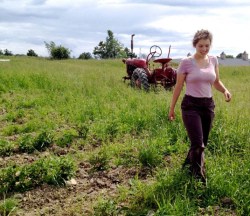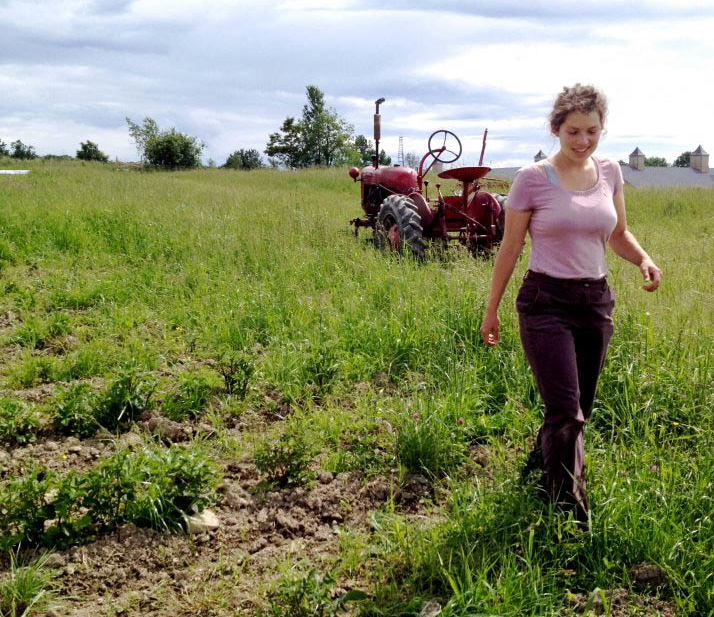
Without a renewed farm bill, training for young farmers like Sophie Ackoff is in danger.
Now that Congress has returned to Washington for the lame duck session, its members could conceivably decide to pass a farm bill. In other news, giant pancakes could also fall from the sky.
In all seriousness, Congress’ non-action on most things this year has left it with a few other pressing things to worry about, so it’s probably not worth holding our breath.
That said, many sustainable food and farming groups are pushing for a farm bill before the end of the year. The National Sustainable Agriculture Coalition (NSAC) and 40 other organizations have sent a letter to House Speaker John Boehner (R-Ohio), and the group is urging anyone interested in investing in the future of healthy farms, food, and people; protecting air, soil, and water; and fixing farm subsidies that privilege big corporate farms to let Congress know what they think by Nov. 15.
To recap: After a promising summer in which both the Senate and the House came up with two very different versions of the farm bill, the GOP-controlled House stalled by refusing to put the bill on the agenda. Then the multibillion-dollar food and farming legislation expired at the end of September.
All along, the biggest farm bill questions have been about two things: conservation and crop insurance. The former has to do with protecting the bill’s fairly large conservation title, which provides money for farmers who either set their land aside for wildlife or farm it in ways that protect the water and soil — efforts that can also often protect farmers against natural disasters like drought and flood. The crop insurance question is a longer story, but one that can be summed up this way: Big farmers want to insure their crops against disaster (a fair request), but they also want the government to insure their income at a fixed level. It’s an expensive proposal that has many critics.
As you can imagine, the Democratic-controlled Senate and the GOP-controlled House have very different takes on both issues. And that’s no doubt part of why they’ve been in such a deadlock this year. (It doesn’t help that the House wants to slash food stamps, too.)
Putting those huge issues aside for a moment, the fact is that the longer we go without a farm bill, the closer we come to putting the most promising things going on in the world of sustainable food and farming in jeopardy.
And, in the case of our already broken dairy industry, as Dan Imhoff wrote in Slate last month, the impact is already being felt. Imhoff wrote:
When the Farm Bill expired on Sept. 30, the Milk Income Loss Contract program, which compensates dairy farmers when milk prices drop in relation to feed costs, ended abruptly. Feed grain costs are shooting up, pushed up by drought, the use of corn and soy for biofuel production, and overseas demand. Many operators are selling cattle to survive. With fewer cows producing, the cost of milk and dairy products could soon spike. Some independent dairy farmers most certainly will go under, furthering concentration of ownership in a sector already dominated by mega-dairies.
And that’s not where the urgency ends.
Also at stake is the Beginning Farmer and Rancher Development Program, a $75 million pot of funds that was set aside in 2008, and has helped launch training programs for aspiring young farmers across the country at a time when most farmers — averaging 56 in age — are looking toward retirement.
Then there’s something called the organic cost-share program, which, like the name implies, provides support for thousands of farmers making the transition to farming without synthetic pesticides and fertilizers. It’s an important program because most farmers can’t afford the costs associated with becoming certified organic on their own.
There’s also the Farmers Market Promotion Program, which helps fund marketing for community-supported agriculture (CSA) programs, farmers markets, roadside stands, and other strategies for selling local produce directly to consumers (versus, say, through a big-box store). This one is big, because it means a higher percentage of each food dollar goes directly to farmers (and stays in the local economy). And the federal dollars that have been spent in this arena in recent years have clearly had an impact — to the tune of 10 percent growth in the number of U.S. farmers markets in 2012 alone.
And there are more, less visible pieces of the puzzle as well, like funding for organic research and value-added products (a great way for farmers to scale up their businesses with products that can bring in more revenue, like jam and salsa). Both are at risk if lawmakers put off this bill.
Some members of Congress have hinted that a one-year extension to the current farm bill is the most likely outcome of this month’s lame duck session. House Majority Leader Eric Cantor (R-Va.), for instance, has repeatedly mentioned his commitment to “resolving the farm bill issue,” but it’s unlikely he’s referring to passing a real, five-year bill when he says that.
One larger question, says NSAC’s Ferd Hoefner, is whether the president — now that he’s done campaigning — will get involved. “There was no agriculture agenda in the campaign, and the administration’s approach to the farm bill has been hands-off,” he told me over the phone last week. “But if the bill doesn’t pass in the next few weeks, it is a question: Will they continue with that same posture?”
It’s likely they will, but Hoefner says we could also see a shift. “They could potentially say, ‘It’s different now, we’re not going to run for reelection, we might as well put more of an oar in the water.’ It could make a real difference if they did.”
Another reason for optimism is the fact that there are five slots for Democrats on the House Agriculture Committee. So, if the bill does get pushed ahead to 2013, there may be a more established sustainable agriculture caucus ready to stand up for programs that benefit small farmers and the environment.
“Ultimately if you want to change the nature of agriculture policy, you have to have good people on the committee,” says Hoefner, who points to the fact that, after the last election, several representatives with clear sustainable agriculture agendas joined the House Agriculture Committee, including Chellie Pingree (D-Maine), Jim McGovern (D-Mass.), and Peter Welch (D-Vermont). And while they’re still junior members, their participation is promising.
“New England has done its job; now we need other regions of the country to step up to the plate, so change can happen,” Hoefner adds.
Of course, most members of Congress will only step up if they know their constituents care about the issue. And that’s where the rest of us come in.



